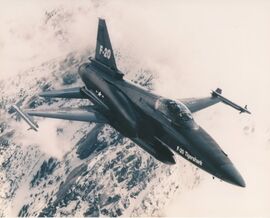The Northrop F-20 Tigershark was an American project of an upgraded F-5E Tiger II to compete with the F-16 Fighting Falcon to replace the F-4 and the F-5 in the United States Air Force and to equip the allies of the U.S, as the F-20 lost the program to the F-16, no countries actually bought the fighter.
Description[]

Northrop F-20 Tigershark
Initially known as the F-5G, Northrop developed the F-20 Tigershark in response to a U.S. Government call for the private development of a tactical fighter specifically tailored to meet the security needs of allied and friendly nations.
The first flight of the Tigershark was made August 30, 1982. The Mach 2 class F-20 Tigershark's basic single-seat configuration was formally designated the F-20A. The F-20 combined propulsion, electronics and armament technologies with improvements in reliability to sustain high sortie rates in adverse weather.
The F-20 incorporated a combination of advanced technology features. The F-20 could carry more than 8,300 pounds of external armaments and fuel on five pylons. It could carry six AIM-9 Sidewinder missiles on air-to-air missions. For air-to-ground missions, more than 6,800 pounds of armament could be carried. Two internally mounted Pontiac M39A2 20mm guns were standard equipment on the Tigershark. Although tests showed it's potential, the USAF never considered the F-20 for service, and the U.S. Air Force decided to purchase F-16As for it's aggressor aircraft program. These two facts essentially doomed the F-20 FMS program. Also, the decision not to buy the F-20 affected other countries decisions on purchasing U.S. aircraft. In all, three F-20s were built, two were destroyed in accidents and the sole survivor now rests in the USAF museum.
Specifications[]
General Characteristics[]
- Crew: 1 pilot
- Length: 47 ft 4 in (14.4 m)
- Wingspan: 27 ft 11.9 in / 8.53 m; with wingtip missiles (26 ft 8 in/ 8.13 m; without wingtip missiles)
- Height: 13 ft 10 in (4.20 m)

F-20 Tigershark droping his bombing payload
- Wing area: 200 ft² (18.6 m²)
- Empty weight: 13,150 lb (5,090 kg)
- Loaded weight: 15,480 lb (6,830 kg)
- Max takeoff weight: 27,500 lb (11,920 kg)
- Powerplant: 1× General Electric F404-GE-100 turbofan, 17,000 lbf (76 kN)
Performance[]
- Maximum speed: Mach 2+
- Combat radius: 300 nmi (345 mi, 556 km) ; for hi-lo-hi mission with 2 × 330 US gal (1,250 L) drop tanks
- Ferry range: 1,490 nmi (1715 mi, 2759 km) ; with 3 × 330 US gal (1,250 L) drop tanks
- Service ceiling: 55,000 ft (16,800 m)
- Rate of climb: 52,800 ft/min (255 m/s)
- Wing loading: 81.0 lb/ft² (395 kg/m²)
- Thrust/weight: 1.1
Armament[]
- Guns: 2× 20 mm (0.79 in) Pontiac M39 cannons in the nose, 280 rounds each
- Hardpoints: Five external hardpoints with a capacity of 8,000 lb (3,600 kg) of bombs, missiles, rockets and drop tanks for extended range
- Rockets: 2× CRV7 rocket pods Or
2 × LAU-10 rocket - Bombs: Mark 82 Bomb
Related Development[]
Comparable Aircraft[]
The original article can be found at Northrop F-20 Tigershark and the edit history here.